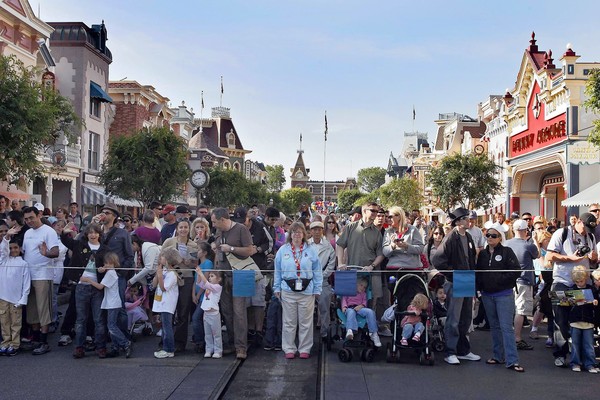Visitors on Main Street U.S.A. await Disneyland’s opening after… (Allen J. Schaben, Los Angeles…)
When the last Jungle Cruise boat docks for the night and lights fade to black on Sleeping Beauty's Castle, the real work begins.
At lush Pixie Hollow, gardeners don miner's headlamps as they begin uprooting stubborn weeds. On Main Street, custodians scrape chewing gum off the sidewalk. And over at Mickey's Toontown, painters sand and recoat chipped handrails.
Few see it happen, except perhaps for the dozens of feral cats that emerge from their hiding places to prowl the park after hours, stalking rodents.
Welcome to the dark side of Disneyland.
Gone are Mickey and his friends. In their place are about 600 custodians, painters, gardeners and decorators, working to ensure that the 85-acre park meets the squeaky-clean ideals that Walt Disney himself extolled even before he launched the park 55 years ago.
During a recent overnight shift, Disneyland provided a rare glimpse into the work that goes into maintaining the world's second-most-popular theme park. Though park officials wouldn't divulge how much money is spent on Disneyland's overall upkeep, they said most is spent on the night shift.
And although most guests will never witness the after-hours work, theme park experts credit the park's continued success to its cleanliness and tidy conditions.
"Disney and many other parks recognize that keeping it clean and refreshed, with all of those little details that you don't notice until they are missing, are important to the park's success," said Gene Jeffers, executive director of the Themed Entertainment Assn., a nonprofit organization of designers and builders of theme parks and attractions.
It's one of the many reasons attendance at Disneyland jumped 8% last year despite the economic downturn, while the crowd numbers dropped at Southern California competitors like Universal Studios Hollywood, Six Flags Magic Mountain and Knott's Berry Farm, according to a recent estimate.
To keep the park in good order, it takes a crew that works 365 nights a year, toiling under portable floodlights. "It's a city that never sleeps," said David Caranci, the manager of resort enhancement and decorating. "There is something always happening."
And for nearly every nighttime task, there is a specific worker.
Three workers are responsible solely for repairing and replacing the 800 umbrellas, 25,000 chairs and about 7,000 tables in the restaurants and snack bars in Disneyland and neighboring California Adventure Park.
Four certified divers collect submerged trash and make repairs on water attractions like Finding Nemo and the Jungle Cruise.
The work can often be tedious and occasionally bizarre. At the Enchanted Tiki Room, a 17-minute musical show features 225 robotic birds, plants and singing tikis. Patrick Pendleton, the show's primary mechanic, has seen it more times than he can count.
To make sure the characters work properly, he plays the show repeatedly, watching each closely. "It's hard to catch everything in one show," he said.
Sometimes, the jobs require ingenuity, even for some of the more distasteful chores. For example, the Indiana Jones Adventure ride relies on nearly 1,000 black lights that shine on painted mesh screens to create floating ghost images.
But the effect is marred when guests sometimes spit at the ghosts, and the saliva ends up on the screens where it glows under black lights. Because typical cleaning products bleach the screens, David Graefen, the ride's service manager, said his crew created a special saliva-cleaning solution.
Park workers have also found a resourceful way to remove other unwanted guests — rodents.
Years ago — no one seems to know when — feral cats began to sneak into the park, living among the park's trees and shrubs during the day. At night, they venture out, and an estimated 200 cats now prowl through Disneyland and neighboring California Adventure Park.
But instead of evicting the cats, Disneyland's animal wranglers work to control the feline population by spaying and neutering the adult cats and finding homes for all kittens born in the resort. The cats eat at five permanent feeding stations installed throughout the two parks.
"We are not trying to get rid of them," said Gina Mayberry, manager of Disneyland's Circle D ranch, where the park's animals are housed. "They keep the rodent population down."
Other nighttime visitors are not so welcome. Before maintenance crews take over, security workers sweep through the park to find guests hoping to spend the night. (Don't even try hiding on Tom Sawyer's Island — park security knows all the hiding places.)
"If someone tried to hide, they would not stay hidden for long," said Disneyland spokeswoman Suzi Brown.
The primary goal of the after-hours crew is to pursue Disney's vision of an immaculate land, free of the litter and grime of the outside world.

